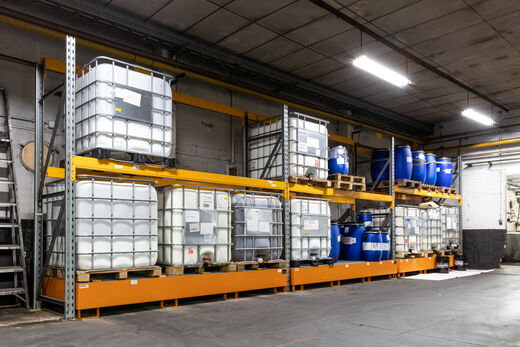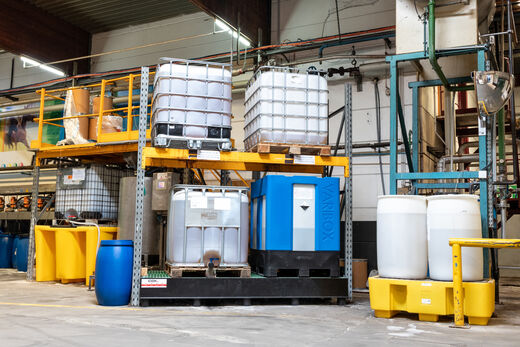Collection bins and drip trays guidelines
A drip pan or catch basin under your storage area prevents leaked liquids from seeping into the soil or spreading across the floor

Collection volume of sump trays in or outside a protected area
Different rules apply to the minimum storage volume depending on the area where the hazardous substances are stored.
Collection volume for sump trays in a protected zone or water catchment area
Provide a full containment volume for all hazardous substances or 100% of the total substances stored.
Collection volume for collection trays outside a protected zone or water extraction area.
Ensure a collection volume of 10% of the total volume you wish to store, with a minimum capacity equal to 100% of the largest container.
For P1 or P2 products, provide 25% of the total volume, also with a minimum capacity equal to 100% of the largest container. (This can be reduced to 10% with approval from the fire department.)

Steel collection tray or plastic collection tray?
- Plastic collection trays (PE): for corrosive products.
- Steel collection trays: for flammable products that can be grounded in case of static electricity.
- For other products, any type of drip tray can be used.
Need collection tray(s)?
Get more information or request a free, no-obligation quotation
Frequently asked questions: Collection bins and drip trays guidelines
No, you cannot just store all products together.
It is important to know exactly what products you are dealing with and which substances they can or cannot come into contact with. This applies not only to collection trays but also to storage in safety cabinets, storage containers, etc.
In addition to separate collection trays, certain distances must be maintained between different hazard groups.
Tip: It's best to create an inventory of the different product groups.
Yes, but
No precipitation should enter the tray. Therefore, it can be placed under a canopy or an impermeable protective cover. The reason for this is quite logical: if rainwater enters the collection tray, the collection capacity decreases, and the initial collection volume can no longer be guaranteed.
No, a drain valve poses a risk of leakage and therefore cannot guarantee 100% liquid-tightness.
Yes, a collection tray guarantees a certain collection volume.
If it is partially filled, its collection volume may not be sufficient to handle new full containers.
Tip: placing absorbent pads in a collection tray preventively makes it easy to remove them and keep the collection tray empty.
Tips & regulations
Placement of the collection tray
For every form of storage, there is a collection tray (drip tray). The most common types are:
- standard collection tray for the storage of drums and IBCs
- collection trays to place in and under warehouse racking,
- work floors for the active use of chemicals,
- smaller drip trays for placement in racks, cabinets, etc.
Material selection for collection trays
- For corrosive products, we recommend a plastic (PE) collection tray.
- It is better to place flammable products on a steel collection tray that can be grounded in case of static electricity.
- For other products, you can choose either option.
